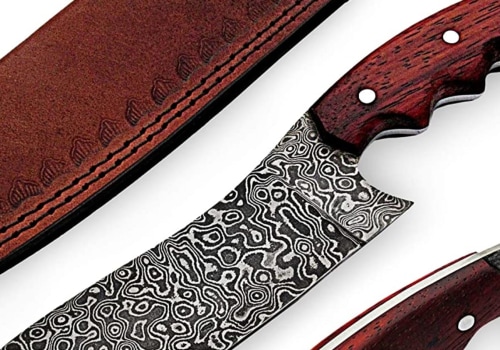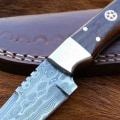When it comes to making a high-quality knife, choosing the right type of steel is one of the most important decisions you can make. From toughness to corrosion resistance, the steel used in a knife blade has a direct impact on the overall performance and longevity of the knife. With so many different types of steel available, it can be difficult to know which one is best for your particular knife project. In this article, we'll explore the different factors to consider when selecting steel for your knife blade, so you can make an informed decision. We'll also provide an overview of some of the most commonly used knife steels, so you can get a better sense of what's out there and determine which type of steel is best suited to your needs. When making a handmade knife, choosing the right steel is an important decision.
Different types of steel have unique properties that can affect the performance of your blade and how it will handle in different conditions. This article will explain the basics of steel selection for knife blades and provide an overview of different types of steel and their characteristics.
Carbon Steel
is made by adding carbon to iron. Carbon steel is typically used for knives because it is hard and can hold a sharp edge for a long time. It is usually easy to sharpen, but it does tend to corrode easily, so it needs to be oiled or waxed regularly.Carbon steel blades are generally strong and durable, making them ideal for use in hard conditions. Examples of knives made from carbon steel include the Kukri, Bowie knife, and some pocket knives.
Stainless Steel
is an alloy of iron and chromium, and it is much more resistant to corrosion than carbon steel. Stainless steel blades are generally harder than carbon steel blades and hold their edge longer, but they are more difficult to sharpen. They are also less durable and more prone to breaking under hard use.Examples of knives made from stainless steel include kitchen knives, diving knives, and some pocket knives.
High-Carbon Stainless Steel
is an alloy of iron, chromium, and carbon. It is more resistant to corrosion than regular stainless steel, but it is also harder and can hold an edge better. High-carbon stainless steel blades are usually more expensive than other types of blades, but they are also more durable and can be used in a variety of conditions. Examples of knives made from high-carbon stainless steel include tactical knives and some pocket knives.Tool Steel
is a type of high-carbon steel that is usually used for making tools such as chisels, drills, saws, and punches.It is very hard and resistant to wear, making it ideal for use in heavy-duty tasks. Tool steel blades are usually more expensive than other types of blades but they can be used in a variety of conditions. Examples of knives made from tool steel include hunting knives, machetes, and swords.
Damascus Steel
is a type of steel that has been used since ancient times. It is made by folding layers of different types of steel together and then forging them into one piece.Damascus steel blades are highly sought after due to their unique patterns and strength. They tend to be very expensive but they can hold an edge for a long time and are very resistant to corrosion. Heat treatment and tempering are important processes for creating a strong, durable blade. Heat treatment involves heating the blade to a high temperature before cooling it quickly. This helps to strengthen the blade by changing its internal structure.
Tempering involves reheating the blade at a lower temperature after heat treatment in order to make the blade more flexible. Different tempering techniques can be used to achieve different levels of hardness and flexibility. It is important to test a blade before using it. Blades can be tested for hardness by using a file or diamond tester. Flexibility can be tested by bending the blade with your hands or using a spring balance.
Edge retention can be tested by cutting paper or slicing through materials such as leather or plastic. Finally, it is important to take care of your blade in order to ensure that it lasts for many years. Sharpening your blade regularly will help maintain its edge retention and keep it from becoming dull or damaged. It's also important to store your blade correctly in order to prevent rust or corrosion.
Testing a Blade
Testing a blade before using it is a necessary step to ensure that it is strong and durable. The most common way to test a blade is to do a flex test, which involves bending the blade and then measuring the amount of flex it has.A good knife blade should only flex slightly without breaking or having too much deformation. Additionally, it is important to check the blade for signs of wear and tear, such as chips and scratches, which can indicate a possible issue with the construction of the blade. In addition to the flex test, there are other tests that can be done to check the quality of a blade. For example, it is important to check for cracks or other defects in the steel that may not be visible with the naked eye.
The hardness of the steel can also be tested with a hardness tester, which is a device that measures how hard a material is. Different types of steel have different hardnesses, so it is important to know what type of steel the blade is made from before testing. Finally, it is important to test the sharpness of the blade. This can be done by running your finger along the edge of the blade and feeling for any rough or jagged areas.
If there are any, then it may be necessary to sharpen the blade before use.
Heat Treatment and Tempering
Heat treatment and tempering is a process used to create a strong and durable blade. Heat treatment involves heating the steel to a high temperature and then cooling it rapidly. This process can improve the strength of the steel by increasing its hardness, while also providing better wear resistance and improved corrosion resistance. Tempering is a process where the steel is reheated in order to achieve a balance between hardness and toughness.This helps to reduce brittleness and improve the overall toughness of the blade. The type of steel used for knife blades will determine what kind of heat treatment and tempering is necessary. Harder types of steel require higher temperatures and longer periods of time for heat treatment. Soft steels require lower temperatures and shorter periods of time for heat treatment. The type of heat treatment used will also depend on the intended use for the knife blade.
For example, some knife blades may require a specific level of hardness for different tasks, such as cutting or chopping. It is important to note that heat treatment and tempering are not a one-time process. A knife blade should be heat treated and tempered multiple times during the manufacturing process in order to achieve the desired properties. Additionally, it is important to use proper techniques when heat treating and tempering steel in order to ensure that the blade has the optimal properties for its intended use.
Types of Steel for Knife Blades
When it comes to selecting steel for knife blades, there are a variety of options available. Each type of steel has its own unique properties, which can affect the performance of the blade and how it will handle in different conditions.This article will provide an overview of the different types of steel and their characteristics.
Carbon Steel
: Carbon steel is one of the most common types of steel used for knife blades. It is strong, durable, and relatively easy to sharpen. Carbon steel blades are often preferred by knife makers because they are easy to work with and can hold an edge well. However, they are susceptible to corrosion and rust if not cared for properly.Stainless Steel
: Stainless steel is another popular choice for knife blades due to its corrosion-resistant properties.It is also harder than carbon steel and can hold an edge longer. However, stainless steel is more difficult to sharpen than carbon steel and may require special tools or techniques.
High-Speed Steel
: High-speed steel is a type of tool steel that is designed to be able to withstand higher temperatures than conventional steels. It is harder than stainless steel and can hold an edge for longer periods of time. However, it is more expensive than other types of steel and may require specialized tools for sharpening.Titanium
: Titanium is a lightweight metal that is often used in knife blades due to its strength and corrosion resistance.It can hold an edge longer than other types of steel and is relatively easy to sharpen. However, titanium is much more expensive than other types of steel.
Damascus Steel
: Damascus steel is a type of folded metal that was traditionally used in swordmaking. It has a unique pattern on the blade that is created when two different types of steel are folded together. Damascus steel is highly corrosion-resistant and can hold an edge for long periods of time, but it is also very expensive. Choosing the right steel for your knife blade is an important decision that can affect its performance in different conditions.This article has provided an overview of different types of steel, heat treatment and tempering techniques, and how to test a blade before use. With this information, you will be able to make an informed decision when selecting the right steel for your knife. It is essential to consider the intended purpose of the blade, the properties of different types of steel and how they will perform in different conditions. Heat treatment and tempering techniques can also help to optimize the performance of your knife blade.
Testing the blade before use is also key to ensuring it will meet your requirements.






Leave Reply